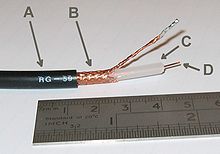A
transmission medium (plural
transmission media) is a material substance (solid, liquid, gas, or plasma) that can
propagate energy waves. For example, the transmission medium for
sound received by the ears is usually air, but solids and liquids may also act as transmission media for sound.
The absence of a material medium (the
vacuum of empty space) can also be thought of as a transmission medium for
electromagnetic waves such as
light and
radio waves. While material substance is not required for electromagnetic waves to propagate, such waves are usually affected by the transmission media they pass through, for instance by
absorption or by
reflection or
refraction at the
interfaces between media.
The term
transmission medium can also refer to a technical device that employs the material substance to transmit or guide waves. Thus, an optical fiber or a copper cable is referred to as a transmission medium.
A transmission medium can be classified as a:
- Linear medium, if different waves at any particular point in the medium can be superposed;
- Bounded medium, if it is finite in extent, otherwise unbounded medium;
- Uniform medium or homogeneous medium, if its physical properties are unchanged at different points;
- Isotropic medium, if its physical properties are the same in different directions.
Electromagnetic radiation can be transmitted through an
optical media, such as
optical fiber, or through
twisted pair wires,
coaxial cable, or
dielectric-slab
waveguides. It may also pass through any physical material that is transparent to the specific
wavelength, such as
water,
air,
glass, or
concrete.
Sound is, by definition, the vibration of matter, so it requires a physical medium for transmission, as does other kinds of mechanical waves and
heat energy. Historically, science incorporated various
aether theories to explain the transmission medium. However, it is now known that electromagnetic waves do not require a physical transmission medium, and so can travel through the "
vacuum" of
free space. Regions of the
insulative vacuum can become
conductive for
electrical conduction through the presence of
free electrons,
holes, or
ions.

No comments:
Post a Comment